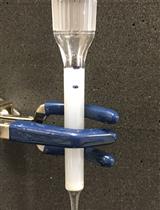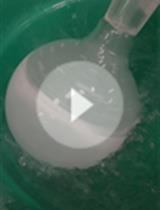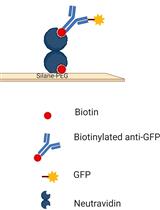- EN - English
- CN - 中文
Single Protein Detection and Imaging with Evanescent Scattering Microscopy
利用倏逝散射显微镜进行单分子蛋白检测和成像
(*contributed equally to this work) 发布: 2022年10月20日第12卷第20期 DOI: 10.21769/BioProtoc.4530 浏览次数: 1831
评审: Zinan ZhouAli Asghar KermaniArif Md. Rashedul Kabir
Abstract
Single-molecule measurements provide statistical distributions of molecular properties, in addition to the ensemble averages. Evanescent detection approaches have been widely used for single-molecule detection because the evanescent field can significantly enhance the light-analyte interaction and reduce the background noise. However, current evanescent single-molecule detection systems mostly require specially designed sensing components. Here, we show that single proteins can be imaged on a plain cover glass surface by detecting the evanescent waves scattered by the target molecules. This allows us to quantify the protein–antibody interactions at the single-molecule level. This protocol describes a label-free single-molecule imaging approach with conventional consumables and may pave the road for detecting single molecules with commercial optical microscopy.
Keywords: Single-molecule imaging (单分子成像)Background
Label-free single-molecule imaging allows the statistical analysis of intrinsic molecular properties such as size, mass, and binding kinetics. Evanescent field can notably increase the light-analyte interaction and suppress the background light by reducing the illumination volume. Traditional evanescent detection approaches, such as surface plasmon resonance (SPR), usually measure the ensemble properties of analytes diffusing into the evanescent field by monitoring the variations of incident light exciting the evanescent field (Homola, 2008; Zhang et al., 2018). In recent years, it has been demonstrated that directly measuring the evanescent waves scattered by the analytes can significantly improve the detection sensitivity and even push the detection limit down to the single-molecule level (Mauranyapin et al., 2017). Plasmonic scattering microscopy (PSM) has further advanced this field by providing wide-field single-molecule imaging capabilities (Zhang et al., 2020). However, PSM employs the surface plasmonic field as the illumination, and the gold film supporting the plasmonic field will generate massive heat at high-incident light intensity, which is required to achieve enough signal-to-noise ratio for single-molecule detection. This thus limits its application in the detection of fragile biological macromolecules, as well as long-term monitoring of molecular binding processes (Zhang et al., 2021).
To further push the evanescent scattering detection approaches forward, we recently developed the evanescent scattering microscopy (ESM), which can perform label-free evanescent scattering imaging of single proteins on plain cover glass surfaces (Zhang et al., 2022). The ESM utilizes total internal reflection to replace the surface plasmon resonance to excite the evanescent field, thus avoiding the heating effect by removing the gold film, and making it suitable for detecting most molecules with conventional consumables. In the following protocol, we describe in detail the construction of an ESM system with commercially available components and its single-molecule imaging operations.
Materials and Reagents
Syringe (BD, catalog number: 302830) with needle (Weller, catalog number: KDS2312P) with the flexible plastic tubing (Tygon, catalog number: AAD04103)
Microfluidic ball valves (Cole-Parmer, catalog number: EW-30600-00)
Cover glasses No. 1, 22 × 22 mm (VWR, catalog number: 48366-067)
Cover glasses No. 1, 18 × 18 mm (VWR, catalog number: 48366-045)
Petri dish (Sigma-Aldrich, catalog number: P5731)
0.22 µm filter (Sigma-Aldrich, catalog number: SLGSM33SS)
Isopropyl alcohol (IPA, VWR, catalog number: BDH2032-1GLP)
Hydrogen peroxide (H2O2, 30%) (Sigma-Aldrich, catalog number: H1009)
(3-aminopropyl) triethoxysilane (APTES) (Sigma-Aldrich, catalog number: 440140)
Succinic anhydride (Sigma-Aldrich, catalog number: 239690)
Bovine serum albumin (BSA) (Sigma-Aldrich, catalog number: A7638)
Sodium hydroxide (NaOH) (Sigma-Aldrich, catalog number: S5881)
Ammonium hydroxide (NH3·H2O, 28.0%–30.0%) (Mallinckrodt Reagents, catalog number: C5103500-2.5D)
1-ethyl-3-(3-dimethylaminopropyl)carbodiimide hydrochloride (EDC) (Thermo Scientific, catalog number: 22980)
Sulfo-NHS (N-hydroxysulfosuccinimide) (Thermo Scientific, catalog number: 24510)
Phosphate-buffered saline (PBS) (Corning, catalog number: 21-040-CV)
Anti-IgA (IgG) (Bio-Rad, catalog number: STAR141)
Human colostrum IgA (Athens Research and Technology, catalog number: 16-13-090701)
Human IgM (Athens Research and Technology, catalog number: 16-16-090713)
Office tape (3MTM ScotchTM, 810, 3/4 in × 108 ft, 1 in Tape Core Dia, Transparent, Matte)
10 g L−1 succinic anhydride (see Recipes)
NH3·H2O, H2O2, and water (see Recipes)
EDC–NHS solution (see Recipes)
Equipment
Optical breadboard (Newport, model: SG-23-4-ML)
Active vibration isolation stage (Accurion, model: Vario Basic 60-300)
80 mW laser diode (Thorlabs, model: PL450B)
Temperature-controlled mount (Thorlabs, model: LDM38)
Benchtop diode current controller (Thorlabs, model: LDC205C)
Temperature controller (Thorlabs, model: TED200C)
Manual translation stage (Thorlabs, model: XR25P-K2)
Posts and Accessories essentials kit (Thorlabs, model: ESK16)
Bases and Post Holders essentials kit (Thorlabs, model: ESK01)
SM1 Lens Tube essentials kit (Thorlabs, model: ESK25)
Ø 2" Optic Mounts essentials kit (Thorlabs, model: ESK19)
Pillar Post essentials kit (Thorlabs, model: ESK15)
Lens Mount essentials kit (Thorlabs, model: ESK22)
C-Mount Extension Tube kit (Thorlabs, model: CML-KIT)
SM2 Lens Tube essentials kit (Thorlabs, model: ESK26)
Cage Assemblies and Lens Tubes essentials kit (Thorlabs, model: ESK07A)
Cage Assemblies and Lens Tubes essentials kit Set B (Thorlabs, model: ESK07B)
Mounted Ø 1" Achromatic Lens kit (Thorlabs, model: LSB08-A)
Cage cube–mounted protected silver turning mirror (Thorlabs, model: CCM1-P01)
Camera (XIMEA, model: MQ003MG-CM and MQ013MG-CM)
25 mm × 36 mm protected silver mirror (Thorlabs, model: PFR10-P01)
Kinematic fluorescence filter cube (Thorlabs, model: DFM1)
SM1A2 adapter (Thorlabs, model: SM1A2)
60 mm cage system translating lens mount (Thorlabs, model: CXY2)
Brass microscope adapter (Thorlabs, model: M2M34S)
Cage plate (Thorlabs, model: LCP08)
Thermally insulating adapter (Thorlabs, model: SM1A3TS)
Zoom housing (Thorlabs, model: SM1ZM)
Reflective ND filter (Thorlabs, model: ND40A)
30–60 mm cage plate adapter (Thorlabs, model: LCP33)
Cage assembly rods (Thorlabs, model: ER18)
Plate (Thorlabs, model: CPVMP)
Kinematic beam-turning cage cube (Thorlabs, model: DFM1-P01)
Dovetail optical rail (Thorlabs, model: RLA1800)
60× objective (Olympus APO N 60× Oil TIRF, NA 1.49)
50× objective (Motic ULWD 50×, NA 0.42)
Achromatic doublet lens (Thorlabs, model: AC508-180-A-ML, AC254-100-AB-ML, and AC254-030-AB-ML)
Ø 1.5" Posts (Thorlabs, model: P6, P8, P10, P12, P14)
Robbins biopsy punch (Robbins Instruments, catalog number: 18271P)
Sylgard 184 silicone elastomer (Dow Silicones Corporation, catalog number: 04019862)
Potomac laser (1450 South Rolling Road Baltimore MD, 21227, USA)
BD-20AC laboratory corona treater (Electro-Technic Products, catalog number: 12051A)
Oven (Thermo Scientific, model: PR305225M)
Double-coated tape (3M, catalog number: 9628B)
Devcon epoxy (Euro Tool, catalog number: GLU-735.90)
Software
XIMEA CamTool (XIMEA)
MATLAB (MathWorks)
Fiji (https://imagej.net/Fiji)
Origin 2019 (OriginLab)
Office 365 (Microsoft)
Procedure
文章信息
版权信息
© 2022 The Authors; exclusive licensee Bio-protocol LLC.
如何引用
Zhang, P., Zhou, L., Wang, R., Zhou, X., Jiang, J., Wan, Z. and Wang, S. (2022). Single Protein Detection and Imaging with Evanescent Scattering Microscopy. Bio-protocol 12(20): e4530. DOI: 10.21769/BioProtoc.4530.
分类
生物物理学 > 单分子技术
药物发现 > 药物筛选
生物化学 > 蛋白质 > 单分子活性 > 成像
您对这篇实验方法有问题吗?
在此处发布您的问题,我们将邀请本文作者来回答。同时,我们会将您的问题发布到Bio-protocol Exchange,以便寻求社区成员的帮助。
Share
Bluesky
X
Copy link













